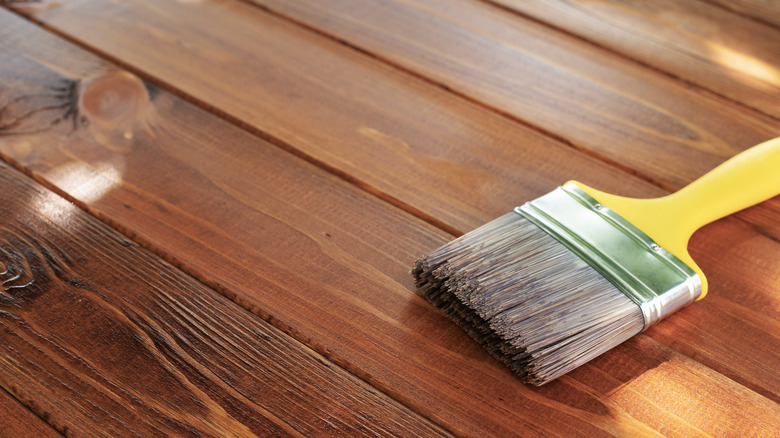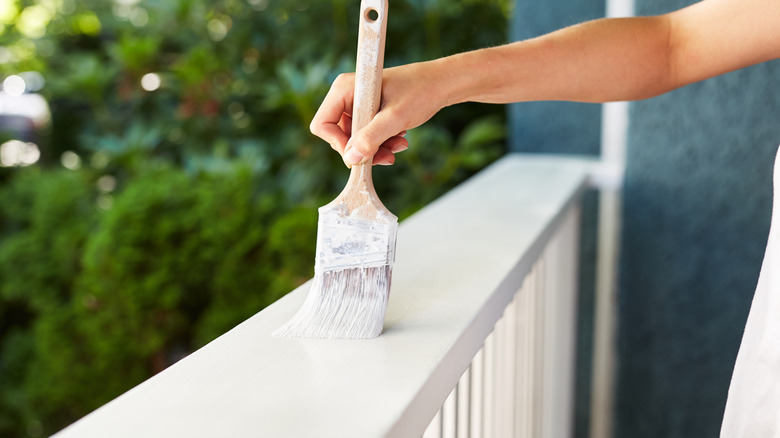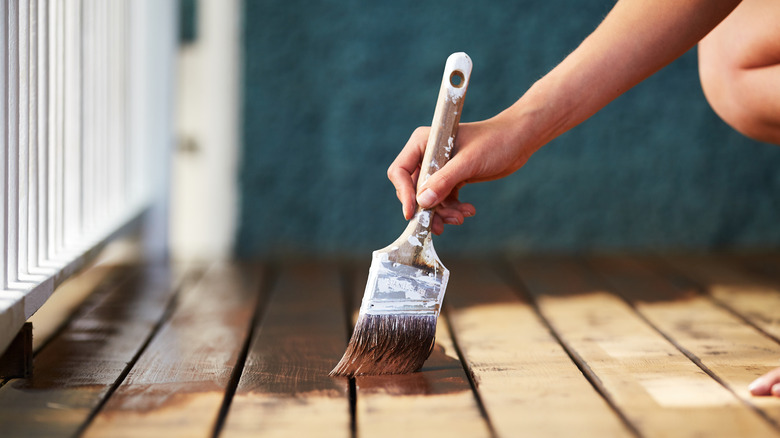Painting Vs. Staining A Deck: Which Is The Better Option?
When it comes to giving your deck some much-needed TLC or a long-overdue makeover, it can be difficult to determine what type of wood treatment will look and wear the best over time – especially with so many different products on the market all claiming to do the same thing.
According to Shoreline Painting, your deck can easily absorb moisture if the wood isn't properly treated, which can lead to cracks and warping. The sun's UV rays can also discolor and fade a deck, whether or not the wood is treated, stained, or painted. Heavy snowfall can also add wear and tear to a deck, and Angi reports that accumulated snow and ice can cause mold and mildew to stain the wood, and the weight of the snow can splinter and warp deck boards.
In addition to durability, you want your deck to be aesthetically pleasing and add curb appeal to your home. Most people will choose to either paint or stain their deck, and determining the pros and cons of each can help you decide which is a better option for you.
What are the differences in cost?
If your goal is to save money, then Angi notes that stain is the better option since it tends to be less expensive than paint. While most deck paint jobs will also require you to invest in primer and wood preservatives, deck stains already have those features included in the product so you can get away with not having to buy multiple cans of different products.
Bob Villa adds that deck paint can cost anywhere from $30 to $60 per gallon — and that's not including the cost of the primer and the wood preservative that you will need to use in conjunction with the paint, which can cost up to $30 and $40, respectively. Stain on the other hand, usually only costs around $20 to $35, and you can finish your whole deck using just one product. Gutterman Services also adds that because painting your deck will likely require a primer and a wood preservative, you will need brushes and rollers for each product, which also increases the overall cost.
How do they differ in apearance?
Unlike paint, stain helps to seal the wood, notes Shoreline Painting, which prevents rot caused by moisture that penetrates the wood. Because stain seeps into the cracks, Shoreline Painting also notes that it can highlight the natural beauty of the wood in your deck, which homeowners will likely want if their deck is in good condition or if the wood is of a high-quality. Those looking for a natural and subtle finish to their deck are better off grabbing a can of stain, as paint conceals the natural beauty of the wood that some people might want to show off.
Alternatively, for those looking for a broader range of color choices, Shoreline Painting says painting might be your best option – especially if you have an older deck. Angi adds that because paint dries opaque and gives the wood on your deck a less natural finish than stain, it is typically the better option for older decks, as it can more easily conceal cracks and wear over time. Because paint completely covers the wood grain, the coverage that stain provides is more subtle because it seeps into any cracks as opposed to concealing them.
Durability and maintenance
If longevity is your goal, Angi says painting is likely the best option since the finished product tends to last longer than deck stain — a high-quality paint job on your deck can last well over ten years, while stain will need to be refreshed every couple of years. Not only will the paint last longer on your deck than a stain, but it also lasts longer on the shelf than a stain does; which means you can get away with storing any extra paint for longer.
While most people would consider the longer lifespan of paint to be a positive, it does also means it will be harder to change your mind about the paint if you don't particularly love the outcome or the color. Paint will need to be sanded off before you attempt to repaint it again. Stain fades gradually over time, and so while it needs to be redone more often than a paint job does, it is often less labor-intensive when it does come time to touch it up.



